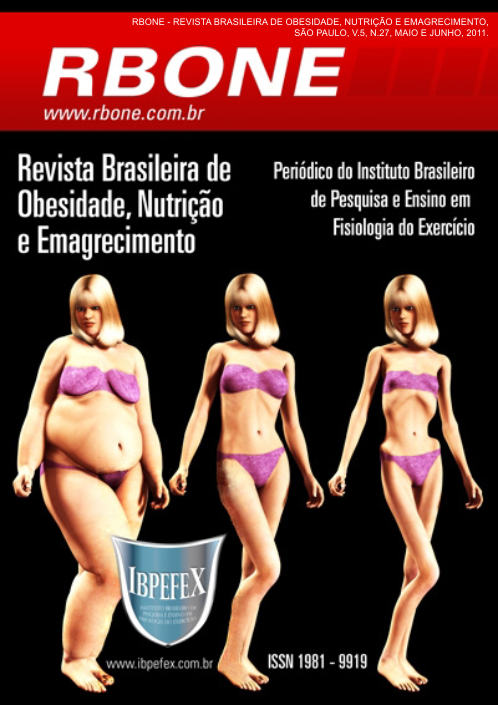Prevalence of metabolic syndrome in patients with obesity grade I
Abstract
Introduction: Metabolic syndrome is defined as a group of some of the following characteristics: central obesity, insulin resistance, and atherogenic dyslipidemia. Obesity is considered a worldwide public health problem, with a rapid increase in prevalence.Objectives:To determine the current nutritional status of the patient, and intervene with measures and methods to improve its clinical status.Methods:A 51-year-old female patient was evaluated. A questionnaire was applied to determine the nutritional status and an anthropometric evaluation was done.Results: The anthropometric evaluation along the nutritional follow-up showed a gradual reduction in the patient’s measures, as well as body weight and Body Mass Index (BMI), that were initially 87,90kg and 34,34(kg/m²) in the first visit, went to 84,00kg and 32,81(kg/m²)in the second consultation, and ended with 31.91(kg/m²)and 81.00kg.Discussion:The improvement in carbohydrate metabolism can be explained by the decreased intake of nutrients, providing weight loss as was the case of the patient who had a weight loss of 7.8%, being enough to demonstrate improvements in her clinical condition, such as blood glucose levels that went from 109.9 mg/dl to 99.1 mg/dl.Conclusion:After evaluating and comparing the results of this study, the conclusion was that the patient reported an inadequate amount of ingested calories, resulting in an excess weight classified as grade 1 obesity.
References
-Carvalho, E. B.; Sales, T. R. A. Avaliação nutricional: a base da escolha terapêutica. In: Carvalho, E. B. (Ed.) Manual de suporte nutricional. Rio de Janeiro: Medsi. 1992. Cap. 3. p. 21-39.
-Carvalho, K.M.B. Obesidade. In: Cuppari, L. (ed.). Nutrição: nutrição clínica do adulto. Barueri: Manole. 2002. p. 131-50.
-Chumlea, W. M. C.; Roche, A. F.; Steinbaugh, M. L. Anthropometric approaches to the nutritional assessment of the elderly. In: Munro, H.; Danford, D. E. (Ed.) Human nutrition: nutrition, aging, and the elderly. New York. Plenum Press. 1989. Cap. 8, p. 335-61.
-Eckel, R.H.; Grundy, S.M.; Zimmet, P.Z. The metabolic syndrome. Lancet. 2005. p. 1415-28.
-Glaner, M.F.; Rodriguez Añez, C.R. Validação de equações para estimar a densidade corporal e/ou percentual de gordura para militares masculinos. Trein Desportivo .Vol. 4. 2001. p. 29-36.
-International Diabetes Federation. The IDF worldwide definition of the metabolic syndrome, 2005.
-Kelly, T.M.; Jones, S.B. Changes in serum lipids after gastric bypass surgery. Lack of relationship to weight loss. Int J Obes. Vol. 10. Núm. 6. 1986. 443-52.
-Michels, K.B.; Greenland, S.; Rosner, B.A. Does body mass index adequately capture therelation of body composition and body size to health outcomes? Am J Epidemiol. Vol. 2. 1998. p. 167-172.
-Miname, M.H.; Chacra, A.P.M. Síndrome metabólica. Rev Soc Cardiol. Vol. 15. Núm. 6. 2005. p. 482-9.
-Nutrition Screening Initiative. Nutrition interventions manual for professionals caring for older Americans. Washington, DC: Nutrition Screening Initiative. 1992.
-Organização Mundial de Saúde. Necessidades de energia e de proteínas. Série de informes técnicos. Ginebra. Suiza. 1985.
-Santos, C.R.B.; Portella, E.S.; Avila, S.S.; Soares, E.A. Fatores dietéticos na prevenção e tratamento de comorbidades associadas à síndrome metabólica. Campinas. 2006. Revista de nutrição. Vol. 19. Núm. 3
-Silveira, V.M.F.; Horta. Peso ao nascer e síndrome metabólica em adultos: meta-análise. Revista de saúde pública. São Paulo. Vol. 42. Núm. 2. 2008.
-Velásquez-Meléndez, G.; Kac, G.; Valente, J.G.; Tavares, R.; Silva, C.Q.; Garcia, E.S. Evaluation of waist circumference to predict general obesity and arterial hypertension in women in Greater Metropolitan Belo Horizonte, Brazil. Cad. Saúde Pública. Vol. 18. 2002. p. 765-71.
-World Health Organization. Diet, nutrition and the prevention of chronic diseases. Geneva. World Health Organization. 2003.
-World Health Organization. Physical status: the use and interpretation of anthropometry. Geneva. World Health Organization. 1995.
-Who. Obesity: Preventing, and Managing the Global Epidemic. Geneva. World Health Organization WHO Consultation on Obesity. 1998.
-Who. Obesity: Preventing and Managing the Global Epidemic. Report of a WHO consultation. World Health Organ Tech Rep Ser. Vol. 894. 2000. p. 1-253.
-Yao, M.; Roberts, S.B.; Ma, G.; Pan, H.; McCrory, M.A. Field methods for body composition assessment are valid in healthy Chinese adults. J Nutr.Vol. 2. 2002. p. 310-7.
Authors who publish in this journal agree to the following terms:
- Authors retain the copyright and grant the journal the right of first publication, with work simultaneously licensed under the Creative Commons Attribution License BY-NC which allows the sharing of the work with acknowledgment of the authorship of the work and initial publication in this journal.
- Authors are authorized to enter into additional contracts separately for non-exclusive distribution of the version of the work published in this journal (eg, publishing in institutional repository or book chapter), with acknowledgment of authorship and initial publication in this journal.
- Authors are allowed and encouraged to post and distribute their work online (eg, in institutional repositories or on their personal page) at any point before or during the editorial process, as this can bring about productive change as well as increase impact and impact. citation of published work (See The Effect of Free Access).






